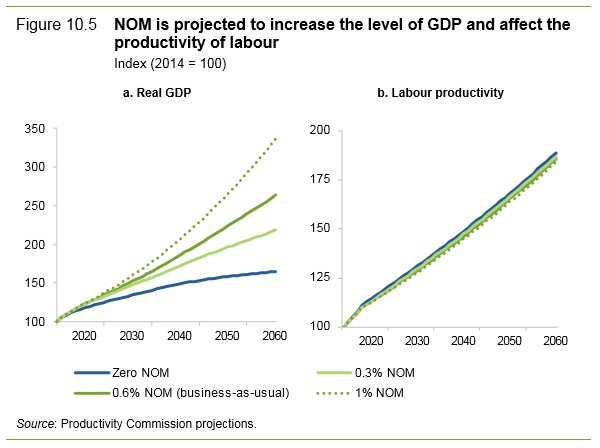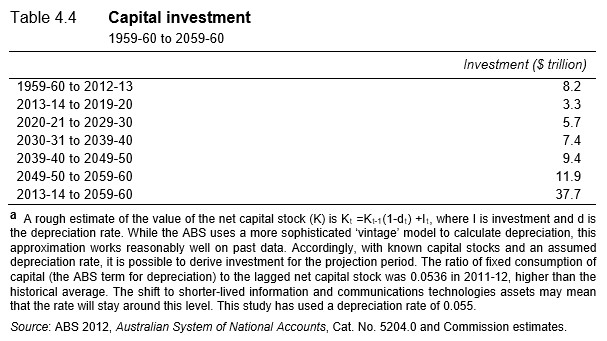Another economist has stepped up to the plate to challenge my view that Australia’s immigration program is way too high and is lowering Australian living standards.
In The Guardian yesterday, Tom Westland penned an article entitled “Australians are getting poorer – but it has nothing to do with immigrants”, which noted the following with respect to my interview on The Bolt Report earlier this month (watch interview above):
…other people have taken to blaming Australia’s high immigration rates for the slide. Leith van Onselen, for example, on the Bolt Report, noted that Victoria, which has seen the highest immigration rates in Australia, has seen the lowest per capita income increase in the country since the global financial crisis. Isn’t that evidence that immigrants are lowering our living standards?
The problem for Van Onselen is that he’s got his economics wrong, and he’s measuring the wrong thing. Changes in gross state product per capita – the indicator they’re using – can’t tell you anything about the impact of immigration on living standards.
It’s like comparing oranges in 2009 with a mix of apples and oranges in 2016.
Let’s call one group of people the “original” group – people who were already here in 2009 – and the other the “immigrant” group, who’ve moved here since then. Van Onselen compares the living standards of the “originals” in 2009 with the living standards of both originals and immigrants in 2016. This tells us nothing. What we want to measure is the change in the living standards of “originals” from 2009 to 2016 (and, if you like, the change for immigrants, but this would mean finding out what those were in their country of origin).
This is much harder to measure, but there is some evidence to suggest that if you did the analysis properly, it would change Van Onselen’s conclusions.
Data from the 2016 census shows that income for recently arrived immigrants in Melbourne is on average substantially lower than it is for Australian-born residents. This means that the recent arrivals will “drag down” the average, even if they’re better off than they were before moving to Australia, and even if they’ve had no impact on the living standards of those who were already living in Melbourne.
The academic literature supports the idea that immigration is not likely to make non-immigrants any poorer. Studies suggest that, on average, immigration has little to no impact on wages. On employment it’s much the same: the consensus of research is that, statistically, immigrants either create more jobs than they “take”, or that they have no impact on jobs at all.
Of course, there is one other legitimate concern people have: that immigrants are straining Australia’s limited resources. Our cities feel crowded and our natural resources are under pressure. But this is almost entirely Australia’s own fault.
We keep on spending billions of public and private dollars on white elephants like the Adelaide-Darwin rail line because we’re too lazy to do the analysis required to allocate infrastructure money efficiently, or because politicians ignore analysis when it’s done. We are bungling the way we manage our water system, and an economically sensible scheme to reduce carbon emissions was abolished after one of the most deceitful political campaigns in Australian history.
In other words, we are as a nation wasting our own resources through sheer political laziness and incompetence.
Punishing aspiring immigrants for this would be like burning a bunch of $100 notes and then complaining that we didn’t have enough money to give to charity. Blaming them for our problems also feeds the kind of doltish hysteria that we’ve seen directed at high-profile immigrants recently. The economy may be turning sour, but that doesn’t mean we have to as well.
Westland has done an excellent job misrepresenting my arguments around Victoria. My central argument in the Bolt report was that excessive levels of immigration are lowering Victorians’ living standards because of the impacts on livability (think traffic congestion, packed trains, smaller and more expensive housing, and environmental degradation), and these are not being offset by rising material living standards, whether measured by per capita GSP or some other measure.
Just look at the data. Melbourne’s population has rocketed by 1 million people (27%) in just 12 years, easily leading the nation:
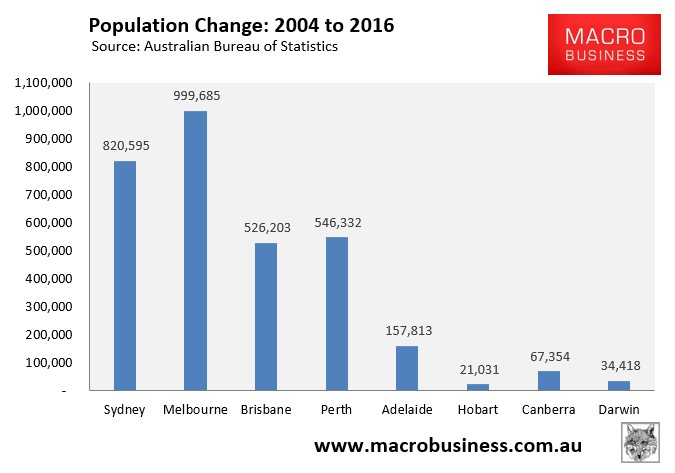
Victorian GSP has barely risen since the GFC:
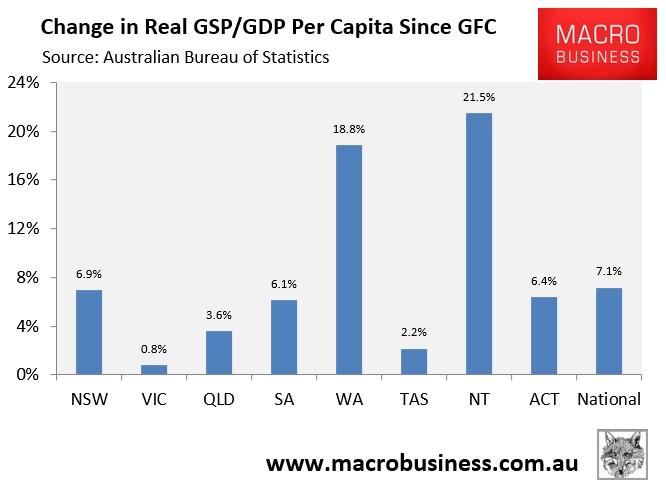
Real per capita state final demand has flatlined:
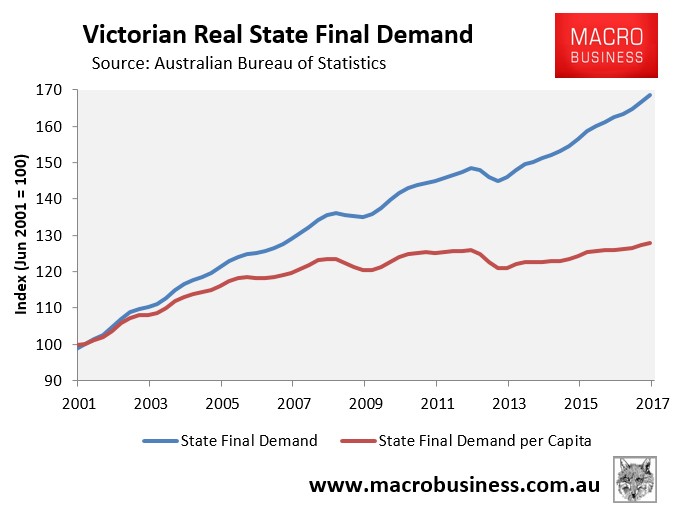
And real per capita wages & salaries have actually fallen by 5.2% over the past decade:
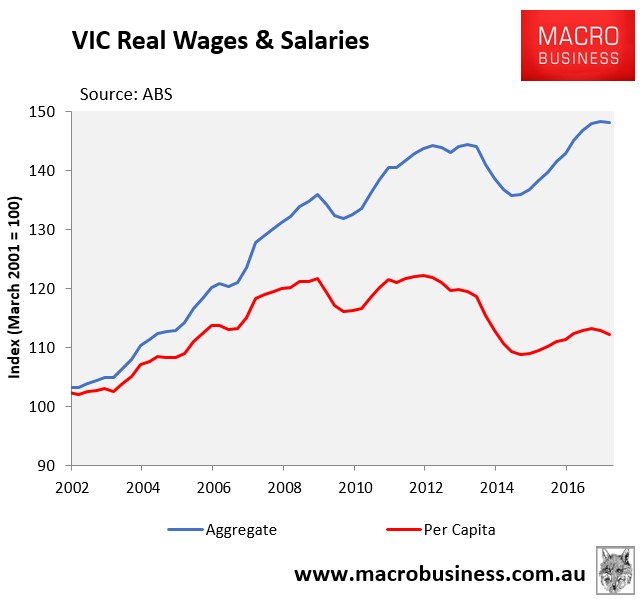
Meanwhile, other indicators of living standards that are not captured in the aggregate economic statistics have unambiguously gotten worse for Victorians. Economic and social infrastructure is becoming increasingly crush-loaded every year as excessive population growth continually outstrips capacity, leading to overcrowding on roads, public transport, and in schools. Housing affordability and rental availability has also deteriorated markedly on the back of the population deluge.
Westland’s argument “that income for recently arrived immigrants in Melbourne is on average substantially lower than it is for Australian-born residents” is itself an argument against ongoing mass immigration. After all, why import huge numbers of people that drag average income down and presumably pay less in taxes than the resident population, but at the same time exacerbate strains on infrastructure, housing and the environment?
Westland’s claim that “academic literature supports the idea that immigration is not likely to make non-immigrants any poorer” is highly debatable.
For example, the Productivity Commission (PC) in 2006 completed a major study on the Economic Impacts of Migration and Population Growth, which modelled the impact of a 50% increase in the level of skilled migration over the 20 years to 2024-25. The modeling found that the benefits from increasing skilled migration accrue to the migrants themselves and wealthy capital owners, whereas existing resident workers are made worse-off. Here’s the money quote:
The increase in labour supply causes the labour / capita ratio to rise and the terms of trade to fall. This generates a negative deviation in the average real wage. By 2025 the deviation in the real wage is –1.7 per cent…
Broadly, incumbent workers lose from the policy, while incumbent capital owners gain. At a 5 per cent discount rate, the net present value of per capita incumbent wage income losses over the period 2005 – 2025 is $1,775. The net present value of per capita incumbent capital income gains is $1,953 per capita…
Owners of capital in the sectors experiencing the largest output gains will, in general, experience the largest gains in capital income. Also, the distribution of capital income is quite concentrated: the capital owned by the wealthiest 10 per cent of the Australian population represents approximately 45 per cent of all household net wealth…
In a similar vein, the PC’s most recent modelling found that labour productivity is forecast to decrease under current immigration settings, as are real wages, versus a zero net overseas migration (NOM) baseline:
Compared to the business-as-usual case, labour productivity is projected to be higher under the hypothetical zero NOM case — by around 2 per cent by 2060 (figure 10.5, panel b). The higher labour productivity is reflected in higher real wage receipts by the workforce in the zero NOM case.
Of course, the PC also noted in its latest report that there are other costs borne by incumbent residents from immigration that are not captured in the economic modelling:
High rates of immigration put upward pressure on land and housing prices in Australia’s largest cities. Upward pressures are exacerbated by the persistent failure of successive state, territory and local governments to implement sound urban planning and zoning policies…
Urban population growth puts pressure on many environment-related resources and services, such as clean water, air and waste disposal. Managing these pressures requires additional investment, which increases the unit cost of relevant services, such as water supply and waste management. These higher costs are shared by all utility users…
Immigration, as a major source of population growth in Australia, contributes to congestion in the major cities, raising the importance of sound planning and infrastructure investment. While a larger population offers opportunities for more efficient use of, and investment in, infrastructure, governments have not demonstrated a high degree of competence in infrastructure planning and investment. Funding will inevitably be borne by the Australian community either through user-pays fees or general taxation…
Increasing numbers of immigrants can adversely affect the quality of Australia’s natural and built environment unless governments take action to mitigate congestion and other pressures. Even with such action, there are additional costs for the community as environmental services have to be replaced with technological solutions…
Moreover, some environmental impacts, such as the recreational value of near empty beaches and the value of biodiversity, are hard to measure, let alone monetise. Yet, such considerations should be part of the broad cost-benefit assessment underpinning decisions on the long-term migrant intake.
Westland’s next point that “our cities feel crowded and our natural resources are under pressure. But this is almost entirely Australia’s own fault… we are as a nation wasting our own resources through sheer political laziness and incompetence” is delusional. It pins the blame solely on the supply-side, while altogether ignoring the fundamental demand-side driver of mass immigration.
Just look at the data: under Australia’s current 200,000 strong permanent migrant program, Australia’s population is projected to increase by some 400,000 annually – effectively adding a Canberra to the country’s population each year:
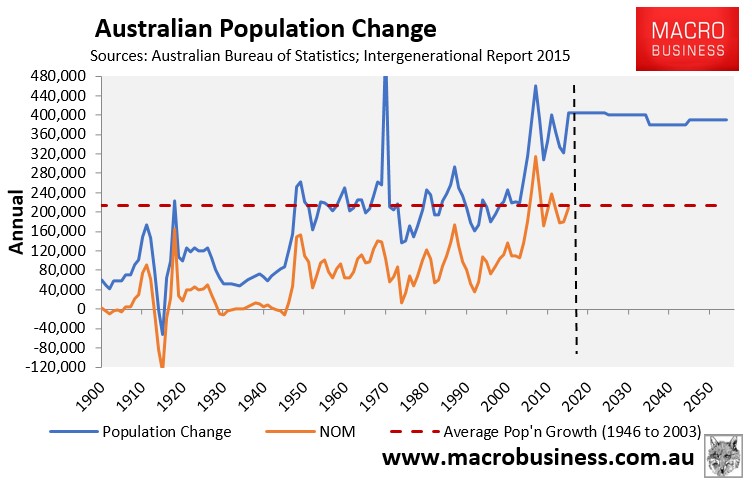
Meanwhile, Melbourne’s population is projected to increase by an insane 97,000 people a year (1,870 people a week) for decades to come:
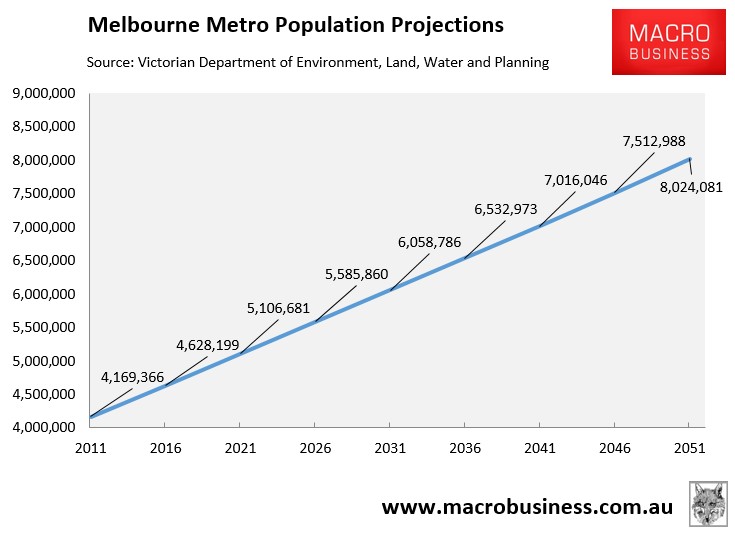
Whereas Sydney’s population is projected to increase by 87,000 people a year (1,650 people a week):
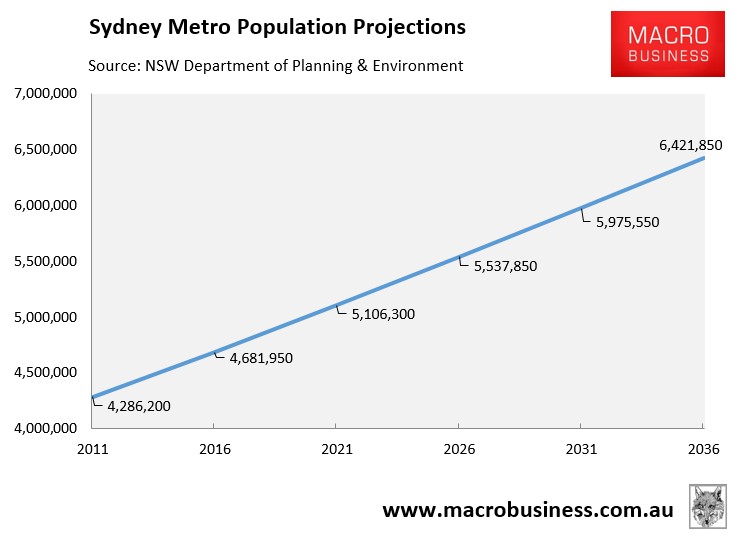
You don’t have to be a rocket scientist to work out that such extreme population growth will create all manner of strains on infrastructure, housing and livability in the major cities.
Given Australia’s governments have failed so dismally in providing infrastructure over the past 15 years of mass immigration, what makes Westlake believe that it can do any better over the next 30-plus years?
Besides, in already built-up cities like Sydney and Melbourne, which also happen to be the major magnets for new migrants, the cost of retrofitting new infrastructure to accommodate greater population densities becomes prohibitively expensive because of the need for land buy-backs, tunnelling, as well as disruptions to existing infrastructure.
We have seen these diseconomies of scale time and time again with hideously expensive projects like the Metro Rail Tunnel, WestConnex, the F6 freeway extension, The Western Harbour Tunnel and Beaches Link tollway, and desalination plants.
Hence, running a high immigration program necessarily becomes increasingly costly for existing residents. The huge infrastructure costs also force unpopular asset sales, increased debt borrowings and austerity – none of which is a desirable outcome.
Perhaps Westland should read the PC’s November 2013 final report on An Ageing Australia: Preparing for the Future, which warned that total private and public investment requirements over the next 50 years are estimated to be more than 5 times the cumulative investment made over the last half century:
Australia’s population is projected to increase to more than 38 million by 2060 [since upgraded to 40 million]… The likely population growth will place pressure on Australian cities… In response to the significant increase in the size of Australian cities, significant investment in transport and other infrastructure is likely to be required. This is true both within the cities themselves and for the links between regional and major cities. Policies will be needed to reduce congestion problems, and to ensure adequate infrastructure funding and investment efficiency…
Total private and public investment requirements over this 50 year period are estimated to be more than 5 times the cumulative investment made over the last half century, which reveals the importance of an efficient investment environment…
Westland would also do well to take a leaf from The Australia Institute’s chief economist, Richard Denniss, who has considered these issues and provided a sobering assessment of Australia’s high immigration program:
“Australia is one of the fastest growing countries in the developed world and our infrastructure isn’t keeping up. It isn’t keeping up now and hasn’t kept up for the last 10 years, and it’s not budgeted to keep up in the next 10″…
“What politicians are doing is every year they announce record spending on this and a new that, but what they don’t point out is that on a per person basis, per person we are spending less on health, per person we’ve got less access to transport, per person the reason the queues in the hospital keeps getting longer is because we are not building hospitals as fast as we are growing our population. They all know it, they just don’t say it”…
“If you want to double your population – and that’s our plan – we want to double our population – you have to at least double your infrastructure to maintain people’s standard of living… We’re talking schools, we’re talking hospitals, we’re talking trains, we’re talking roads, we’re talking police”…
“Population growth costs a lot… If you double the number of citizens then you double the number of teachers and double the number of nurses. It’s pretty simple math. But of course, you don’t have to double them if you gradually plan to lower the number of services. If you are happy for us to gradually lower the number of services in our health system, our aged system, if you are happy for congestion to gradually get worse, if you are happy for the amount of green space per person to decline, then you can do what we do”.
Or take a leaf from Ross Gittins (here and here):
…immigration carries a huge threat to our productivity.
The unthinkable truth is that unless we invest in enough additional housing, business equipment and public infrastructure to accommodate the extra workers and their families, this lack of “capital widening” reduces our physical capital per person and so reduces our productivity…
Lower immigration would help reduce a lot of our economic problems…
On Westland’s final strawman argument, I have absolutely no intention of “punishing aspiring immigrants” or “blaming them for our problems”. All I want is for Australia’s immigration intake to be returned to the sensible and sustainable levels that existed in the 100 years post Federation. Like I said in the Bolt Report interview:
“Instead of growing by one million people every 2.5 years, why not grow by one million people every seven years? That’s still a very generous migrant intake. And it brings us back to a level that existed for a hundred years between Federation and the year 2000 before it was massively increased.
“It seems like a very sensible compromise to take the strain off cities, livability, housing affordability, infrastructure, all those sorts of things. And we can still be a generous migrant country like we always were. We just have to slow down a bit. It’s not rocket science”.
Only one economist here is putting forward an argument based more on ideology than evidence, and it ain’t me!

